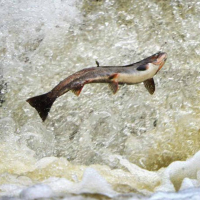Northeastern Marine Life Found Vulnerable to Climate Change
 Atlantic salmon (photo: Getty)
Atlantic salmon (photo: Getty)
By Patrick Whittle, Associated Press
PORTLAND, Maine (AP) — Fish and shellfish that humans rely on for food and that are important to the economy are on a list of Northeastern marine species considered most vulnerable to climate change, a federal government report released Wednesday and published by the journal PLOS ONE said.
The study ranged from Cape Hatteras, North Carolina, to the Gulf of Maine and is the first "multispecies assessment" of the vulnerability of marine fish and invertebrates to climate change, the National Oceanic and Atmospheric Administration said. A series of similar assessments will follow in other regions of the U.S.
NOAA's report assigned a "climate vulnerability score" to 82 Northeastern fish and shellfish species. It listed types of scallop and quahog and the Atlantic salmon as the most vulnerable in the region, as well as eastern oysters, a $175 million fishery in 2014. Also, certain types of herring, a vital part of the ocean's food web and commercially important as bait, were found to be highly vulnerable to climate change.
Lead author Jon Hare, a NOAA oceanographer based in Rhode Island, said scientists found that most of the species they studied will be affected by climate change in some way.
In addition, Hare said, "Those effects are going to continue into the future. We've seen impacts in the past, but this study provides support for the idea that those changes are going to continue."
The 82 species represent every commercially managed marine fish and invertebrate species in the Northeast; the list also includes some popular recreational marine fish and all marine fish listed or under consideration for protection under the Endangered Species Act.
Changing ocean conditions impact marine animals' reproduction, predation and ability to grow. Hare said researchers studied how vulnerable the species are to changes in the ocean's temperature, acidity, salinity and other features.
Also among their findings were:
—About half of the 82 species studied are either highly vulnerable or very highly vulnerable to climate change. About half will likely be negatively affected by climate change and 20 percent will be positively affected by it. The impact on others appears to be neutral, Hare said.
—Some already challenged species such as winter flounder are at risk. Winter flounder have declined from a 15.3 million pound fishery in 2001 to 4.4 million pounds in 2015.
Peter Baker, director of Northeast U.S. oceans for the Pew Charitable Trusts, said the report should be a motivator for fishing managers to protect more ocean habitat and preserve marine species.
"We can better protect the ocean habitat where fish find food and shelter and reproduce," he said.
To Learn More:
Ecosystem Collapse Predicted as Human Activity Lays Waste to Marine Life (by Noel Brinkerhoff and Danny Biederman, AllGov)
“Unprecedented” Toxic Algal Bloom Closing Fisheries on the West Coast (by Ken Broder, AllGov California)
- Top Stories
- Unusual News
- Where is the Money Going?
- Controversies
- U.S. and the World
- Appointments and Resignations
- Latest News
- Musk and Trump Fire Members of Congress
- Trump Calls for Violent Street Demonstrations Against Himself
- Trump Changes Name of Republican Party
- The 2024 Election By the Numbers
- Bashar al-Assad—The Fall of a Rabid AntiSemite






Comments